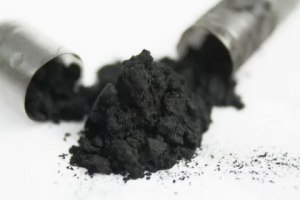The Recovered Carbon Black market focuses on the sustainable production of carbon black from end-of-life tires and other rubber waste through pyrolysis.
NEW YORK , NY, UNITED STATES, August 6, 2025 /EINPresswire.com/ — The Recovered Carbon Black Market encompasses the production, commercialization, and application of carbon black obtained through the thermal decomposition (typically pyrolysis) of end-of-life tires (ELTs) and other rubber-based waste materials. Recovered carbon black is used as a sustainable alternative to traditional, fossil-derived carbon black and serves as a reinforcing filler or pigment in products such as tires, rubber goods, plastics, coatings, and inks.The rCB market is driven by increasing environmental regulations, circular economy initiatives, and the need to reduce dependence on virgin carbon black. It also plays a key role in waste tire recycling, carbon emission reduction, and the development of eco-friendly materials in various industrial sectors.
The Global Recovered Carbon Black Market was valued at USD 1.5 Billion in 2023 and is projected to grow to USD 4.1 Billion by 2032, with a CAGR of 12.20% from 2024 to 2032.
Drivers:
Growing Focus on Sustainability and Circular Economy: With increasing environmental concerns, manufacturers are turning toward sustainable alternatives like recovered carbon black to reduce reliance on virgin carbon black and cut down tire waste.
Rising End-of-Life Tire (ELT) Generation: The global increase in vehicle use leads to a significant rise in ELT volumes, offering a steady and economical raw material source for rCB production.
Cost Advantage over Virgin Carbon Black: Recovered carbon black offers a competitive price point, especially in price-sensitive industries like rubber compounding and plastic manufacturing.
Increasing Demand from Tire and Rubber Industry: Leading tire manufacturers are incorporating rCB into their products to meet sustainability goals and reduce their carbon footprint.
Request a Sample Copy of this Report at
https://www.marketresearchfuture.com/sample_request/7557
Restraints:
Inconsistent Quality and Performance Issues: Variability in feedstock and process conditions can affect the uniformity of rCB, limiting its applicability in high-performance applications.
Limited Awareness and Acceptance: Some industries are still hesitant to adopt rCB due to concerns over consistency, performance, and supply chain reliability.
Technical and Processing Challenges: rCB often requires additional post-processing to match the quality of virgin carbon black, increasing costs and complicating adoption.
Prominent players in the Recovered Carbon Black Market include:
Hi Green Carbon, Pyrolyx AG, Black Bear Carbon B.V., Scandinavian Enviro Systems AB, Delta-Energy Group, LLC, Alpha Carbone, DVA Renewable Energy JSC., Ecolomondo Corporation, Integrated Resource Recovery, Inc., and SR2O Holdings, LLC
Opportunities:
Advancements in Pyrolysis and Purification Technologies: Innovations are improving the efficiency, purity, and yield of rCB, enhancing its market competitiveness and expanding its application range.
Supportive Regulations and Green Procurement Policies: Government regulations encouraging tire recycling and the use of secondary raw materials are expected to support rCB industry growth.
Adoption in Non-Tire Applications: The use of rCB in plastics, coatings, inks, and construction materials is expanding, reducing dependence on a single sector.
Secure Your Copy of the Report:
https://www.marketresearchfuture.com/checkout?currency=one_user-USD&report_id=7557
Challenges:
Lack of Industry Standards: The absence of standardized testing and classification systems for rCB hampers quality assurance and limits broader adoption.
Competition from Virgin Carbon Black Producers: Large, well-established carbon black producers may resist or undercut rCB producers, making market penetration difficult.
Scaling Production and Supply Chain Infrastructure: Building efficient collection, processing, and distribution networks for ELTs and rCB remains a complex and capital-intensive task.
Table of Contents
SECTION I: EXECUTIVE SUMMARY AND KEY HIGHLIGHTS
EXECUTIVE SUMMARY
• Market Overview
• Key Findings
• Market Segmentation
• Competitive Landscape
• Challenges and Opportunities
• Future Outlook
SECTION II: SCOPING, METHODOLOGY AND MARKET STRUCTURE
SECTION III: QUALITATIVE ANALYSIS
SECTION IV: QUANTITATIVE ANALYSIS
SECTION V: COMPETITIVE ANALYSIS
LIST Of tables
LIST Of figures
Continue…
Browse Related Report
Elemental Fluorine Market
https://www.marketresearchfuture.com/reports/elemental-fluorine-market-7789
Glycoprotein Market
https://www.marketresearchfuture.com/reports/glycoprotein-market-10533
Adjustable Boxes Market Adjustable Boxes Market
https://www.marketresearchfuture.com/reports/adjustable-boxes-market-11443
Static Crane Market
https://www.marketresearchfuture.com/reports/static-crane-market-11498
Smart Retail Packaging Market
https://www.marketresearchfuture.com/reports/smart-retail-packaging-market-11501
construction composites market
https://www.marketresearchfuture.com/reports/construction-composites-market-11586
Flexible Insulation Market
https://www.marketresearchfuture.com/reports/flexible-insulation-market-11688
Construction Repair Composites Market
https://www.marketresearchfuture.com/reports/construction-repair-composites-market-12275
Food Biodegradable Packaging Market
https://www.marketresearchfuture.com/reports/food-biodegradable-packaging-market-12338
Pharma Packaging Films Market
https://www.marketresearchfuture.com/reports/pharma-packaging-films-market-12384
Market Research Future
Market Research Future
+ +1 855-661-4441
email us here
Legal Disclaimer:
EIN Presswire provides this news content “as is” without warranty of any kind. We do not accept any responsibility or liability
for the accuracy, content, images, videos, licenses, completeness, legality, or reliability of the information contained in this
article. If you have any complaints or copyright issues related to this article, kindly contact the author above.
![]()

